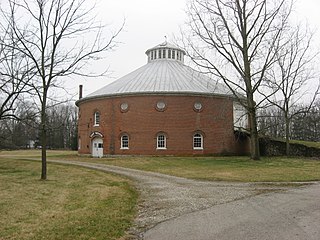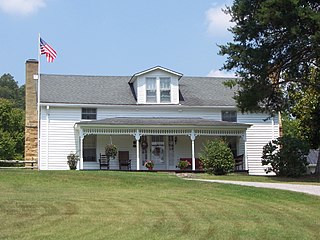Related Research Articles

The Queens County Farm Museum, also known as Queens Farm, is a historic farm located on 47 acres (190,000 m2) of the neighborhoods of Floral Park and Glen Oaks in Queens, New York City. The farm occupies the city's largest remaining tract of undisturbed farmland, and is still a working farm today. The site features restored farm buildings from three different centuries, a greenhouse, planting fields, livestock, and various examples of vintage farm equipment. Queens Farm practices sustainable agriculture and has a four-season growing program.

The Wallace House is a Georgian style historic house, which served as the headquarters of General George Washington during the second Middlebrook encampment (1778–79), located at 38 Washington Place, Somerville, Somerset County, New Jersey, United States. It was added to the National Register of Historic Places on December 2, 1970.

Bridgham Farm is an historic farm in East Providence, Rhode Island. The farm consisted of 46.6 acres (18.9 ha) of land west of Turner Reservoir and east of Pawtucket Avenue. The main farmhouse, built in 1767, now stands on Morra Way, a subdivision created out of some of the farm's lands. A portion of the farmland is now locally managed conservation land by the East Providence Land Conservation Trust. A direct descendant of the family, Clive Willard Bridgham, received the original land grant from King George III. He lived there until he was found murdered in his house on January 11th, 2018.

The Gibbs Farm is a museum in Falcon Heights, Minnesota, United States. The site was once the farmstead of Heman Gibbs and Jane DeBow, first built in 1854; the existing farmhouse includes the small, original cabin. The museum seeks to educate visitors on the lives of 19th-century Minnesota pioneers and the Dakota people who lived in southern Minnesota before the arrival of Europeans.

The William Miller Farm is a historic farm property on County Road 11 in Hampton, New York. It is a historic district that encompasses the home of William Miller, who was a Baptist preacher credited with beginning the mid-nineteenth century North American religious movement that was known as the Millerites. After his prophetic interpretations did not happen as he expected, new heirs of his message emerged, including Seventh-day Adventists and Advent Christians. Later movements found inspiration in Miller's emphasis on Bible prophecy. The property includes Miller's farmhouse, a chapel he built for Adventist worship, and Ascension Rock, the place where some of his followers gathered to await the Second Advent on October 22, 1844.

Crandall Farm Complex is a historic home and farm complex located at Cazenovia in Madison County, New York. The frame farmhouse was built about 1870 and is a two-story, frame residence in the vernacular Italianate style. Also on the property are two barns, carriage house, privy, shed, and cobblestone well house.

Nutwood Place is a historic farm complex on the northern edge of Urbana, Ohio, United States. Today composed of the farmhouse, a round barn, and a small amount of former fields, the farm has been owned by some of Urbana's leading families. Colonel William Ward, the founder of Urbana and the farm's original owner, built the farmhouse in 1815. At this time, he owned 160 acres (65 ha) of land north of the village of Urbana; there he established his farm under the name of "Nutwood Place," where he lived until his 1822 death.

The John W. Keeney and Erena Alexander Rogers Farm, commonly known simply as the Keeney Farm, is a historic district located at 5300 Monroe Street (M-50) in Franklin Township in north-central Lenawee County, Michigan. It was designated as a Michigan Historic Site and added to the National Register of Historic Places on September 24, 2001. The apple orchard has been continuously operating since 1875, and is one of the oldest such orchards in Lenawee County.

Oliver Johnson's Woods is a historic district and neighborhood on the northern side of Indianapolis, Indiana, United States. Located in southern Washington Township, the district occupies the site of what was once the family farm of Oliver Johnson. Born on the present site of the Indiana State Fairgrounds, Johnson grew up in a pioneer family that lived on the edge of the state capital city. Upon attaining adulthood, he bought property a short distance to the west, to which he moved in 1846. Here, he built a larger farmhouse in 1862, and he tilled the soil for most of the rest of his life. As Indianapolis grew northward, it reached the Johnson farm in the early twentieth century; the aged farmer and his sons saw the city's growth as an opportunity for financial gain, and in 1905 they announced the platting of 0.25 square miles (0.65 km2) of their property into individual lots. They chose an advantageous time to sell their property; as the new residents began to build their homes, an interurban railway was built along College Avenue on the district's western side that connected downtown with Broad Ripple. Many prosperous businessmen were attracted by the development's large lots and wooded streets; the city annexed Oliver Johnson's Woods in 1912, and by the outbreak of World War II, the streets were filled with large houses built in a wide variety of architectural styles. These early residents came from many different ethnicities: European immigrants were becoming more prosperous and leaving their ethnic enclaves, and new neighborhoods such as Oliver Johnson's Woods appealed to them. Among the neighborhood's leading residents was a colony of Jews of German descent.

The McCoy Farmhouse is a historic house located at 2925 Syene Road in Fitchburg, Wisconsin. The Italianate farmhouse was built in 1861 on an early Wisconsin tobacco farm. From 1949 to 1978 microbiologist Elizabeth McCoy lived there. In 1980 the house was added to the National Register of Historic Places.

The Franklin Harris Farmstead is a historic farm complex located outside the village of Salem in Columbiana County, Ohio, United States. Once home to a prominent former soldier, the farmstead includes a high-style farmhouse from the 1890s, and it has been named a historic site.

The Perrill–Goodman Farmhouse is a historic farmhouse in the central part of the U.S. state of Ohio. Located south of Groveport in Pickaway County, it has been named a historic site.

The Smith Farmhouse is a historic house in Pasquo, Tennessee, USA.

The McDonald House is a historic residence located west of Winterset, Iowa, United States. William and Barbara McDonald settled in Madison County during the Civil War, and bought this farm in the 1870s. Although not as early as others in the county, this house is a good example of a vernacular limestone farmhouse. This 1½-story structure is composed of locally quarried stone. Its construction is attributed to David Harris, who was one of the last stonemasons still working in the county when this was built. It follows an asymmetrical massed rectangular plan, and it is built on a slightly raised basement. It features two-against-one broken bond, and textured stone characteristic of Harris' work. The house was listed on the National Register of Historic Places in 1993.

The McLemore-Sharpe Farmstead is a historic farm in Toombs County, Georgia, southwest of Vidalia. The farmstead includes two farmhouses and their associated outbuildings. The McLemore farmhouse is a log cabin, of single pen type, built in 1864, with a shed-type front porch and additional shed rooms. The Sharpe farmhouse is a one-story wood frame house built in 1903. The property was listed on the National Register of Historic Places in 1982.

The Maple Dean Farm is a historic farmhouse in Shelbyville, Tennessee, U.S.. Built in 1886 on a farm established in 1819, it was designed in the Eastlake architectural style. It became a century farm in 1976, and it was listed on the National Register of Historic Places in 1976.

The Langford and Lydia McMichael Sutherland Farmstead is a farm located at 797 Textile Road in Pittsfield Charter Township, Michigan. It was listed on the National Register of Historic Places in 2006. It is now the Sutherland-Wilson Farm Historic Site.

The Daniel Pond Farmhouse, also known as Eggleston Farm, is a limestone-walled home built in Rutland, Wisconsin in the 1840s. In 1980 the house was listed on the National Register of Historic Places.

The Frederick Schumann Farmstead is a well-preserved saltbox-shaped stone farmhouse built by a German immigrant family in 1878 in Berry, Wisconsin. In 1993 it was listed on the National Register of Historic Places.

The Fanckboner-Nichols Farmstead is a farmhouse and associated buildings located at 5992 West VW Avenue in Prairie Ronde Township, Michigan. It was listed on the National Register of Historic Places in 2007.
References
- 1 2 "National Register Information System". National Register of Historic Places . National Park Service. November 2, 2013.
- 1 2 3 4 5 6 7 "National Register of Historic Places Inventory/Nomination: Turner, Ida New and William Madison, Farm". National Park Service . Retrieved May 17, 2018. With accompanying pictures
| This article about a property in Wilson County, Tennessee on the National Register of Historic Places is a stub. You can help Wikipedia by expanding it. |